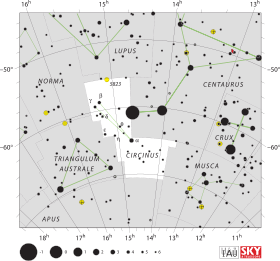Beta Circini
Beta Circini, Latinized from β Circini, is an A-type main sequence star and is the second-brightest star in the constellation of Circinus.[2] It has an apparent visual magnitude of approximately 4.069,[2] which is bright enough to be viewed with the naked eye. Based upon an annual parallax shift of 35.17 mas as seen from the Earth,[2] it is located about 93 light years from the Sun.
| Observation data Epoch J2000.0 Equinox J2000.0 | |
|---|---|
| Constellation | Circinus |
| Right ascension | 15h 17m 30.8488s[1] |
| Declination | −58° 48′ 04.3384″[1] |
| Apparent magnitude (V) | 4.069[2] |
| Characteristics | |
| Spectral type | A3 Va[2] |
| U−B color index | +0.09[3] |
| B−V color index | +0.09[3] |
| Astrometry | |
| Radial velocity (Rv) | 9.6 ± 2[2] km/s |
| Proper motion (μ) | RA: −96.742±0.491[1] mas/yr Dec.: −136.541±0.621[1] mas/yr |
| Parallax (π) | 35.1736 ± 0.4253[1] mas |
| Distance | 93 ± 1 ly (28.4 ± 0.3 pc) |
| Absolute magnitude (MV) | +1.64[4] |
| Details | |
| Radius | 1.3[5] R☉ |
| Luminosity | 19[4] L☉ |
| Surface gravity (log g) | 4.281[6] cgs |
| Temperature | 8676±33[7] K |
| Metallicity [Fe/H] | 0.16[4] dex |
| Rotational velocity (v sin i) | 59[3] km/s |
| Age | 370–500[7] Myr |
| Other designations | |
| Database references | |
| SIMBAD | data |
With a stellar classification of A3 Va,[2] this is an A-type main-sequence star. It is between 370 and 500 million years old[7] with around 1.3[5] times the Sun's radius. The star is radiating 19[4] times the Sun's luminosity from its photosphere at an effective temperature of 8,676 K.[7] It has one known sub-stellar companion.
Planetary System
Beta Circini b is a distant brown dwarf companion orbiting the host star at a distance of 6,656 AU.[8][7] It has a surface temperature of 2,084.0 K. Its mass was estimated using the Spectrum method which concluded that the object has a mass of 56.0±7.0 MJ.[8]
| Companion (in order from star) |
Mass | Semimajor axis (AU) |
Orbital period (days) |
Eccentricity | Inclination | Radius |
|---|---|---|---|---|---|---|
| β Circini b | 56.0 (± 7.0) MJ | 6656.0 | — | — | — | — |
References
- Brown, A. G. A.; et al. (Gaia collaboration) (August 2018). "Gaia Data Release 2: Summary of the contents and survey properties". Astronomy & Astrophysics. 616. A1. arXiv:1804.09365. Bibcode:2018A&A...616A...1G. doi:10.1051/0004-6361/201833051. Gaia DR2 record for this source at VizieR.
- "* bet Cir". SIMBAD. Centre de données astronomiques de Strasbourg. Retrieved September 5, 2008.
- HR 5670, database entry, The Bright Star Catalogue, 5th Revised Ed. (Preliminary Version), D. Hoffleit and W. H. Warren, Jr., CDS ID V/50. Accessed on line September 5, 2008.
- Anderson, E.; Francis, Ch. (2012), "XHIP: An extended hipparcos compilation", Astronomy Letters, 38 (5): 331, arXiv:1108.4971, Bibcode:2012AstL...38..331A, doi:10.1134/S1063773712050015.
- HD 135379, database entry, Catalog of Apparent Diameters and Absolute Radii of Stars (CADARS), 3rd edition, L. E. Pasinetti-Fracassini, L. Pastori, S. Covino, and A. Pozzi, CDS ID II/224. Accessed on line September 5, 2008.
- Song, Inseok; et al. (February 2001), "Ages of A-Type Vega-like Stars from uvbyβ Photometry", The Astrophysical Journal, 546 (1): 352–357, arXiv:astro-ph/0010102, Bibcode:2001ApJ...546..352S, doi:10.1086/318269
- Smith, L. C.; et al. (2015). "Discovery of a brown dwarf companion to the A3V star β Circini". Monthly Notices of the Royal Astronomical Society. 454 (4): 4476–4483. arXiv:1509.09226. Bibcode:2015MNRAS.454.4476S. doi:10.1093/mnras/stv2290. hdl:2299/16835.
- "β Circini b". The Extrasolar Planet Encyclopaedia. Retrieved October 30, 2015.
